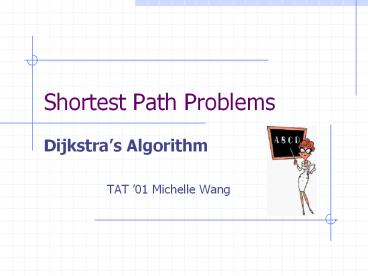Shortest Path Problems - PowerPoint PPT Presentation
Title:
Shortest Path Problems
Description:
Shortest Path Problems. Dijkstra's Algorithm. TAT '01 Michelle Wang. Introduction. Many problems can be modeled using graphs with weights assigned to their edges: ... – PowerPoint PPT presentation
Number of Views:97
Avg rating:3.0/5.0
Title: Shortest Path Problems
1
Shortest Path Problems
- Dijkstras Algorithm
- TAT 01 Michelle Wang
2
Introduction
- Many problems can be modeled using graphs with
weights assigned to their edges - Airline flight times
- Telephone communication costs
- Computer networks response times
3
Wheres my motivation?
- Fastest way to get to school by car
- Finding the cheapest flight home
- How much wood could a woodchuck chuck if a
woodchuck could chuck wood?
4
Optimal driving time
UCLA
25
The Red Garter
19
5
9
the beach (dude)
21
16
31
In N Out
My cardboard box on Sunset
36
5
Tokyo Subway Map
6
Setup
- G weighted graph
- In our version, need POSITIVE weights.
- G is a simple connected graph.
- A simple graph G (V, E) consists of V, a
nonempty set of vertices, and E, a set of
unordered pairs of distinct elements of V called
edges. - A labeling procedure is carried out at each
iteration - A vertex w is labeled with the length of the
shortest path from a to w that contains only the
vertices already in the distinguished set.
7
Outline of Algorithm
- Label a with 0 and all others with ?.
L0(a) 0 and L0(v) ? - Labels are shortest paths from a to vertices
- Sk the distinguished set of vertices after k
iterations. S0 ?. The set Sk is formed by
adding a vertex u NOT in Sk-1 with the smallest
label.
- Once u is added to Sk we update the labels of all
the vertices not in Sk - To update labels
- Lk(a, v) minLk-1(a, v),
- Lk-1(a, u) w(u, v)
8
Using the previous example, we will find the
shortest path from a to c.
a
25
r
19
9
5
b
16
21
31
i
c
36
9
Label a with 0 and all others with ?. L0(a) 0
and L0(v) ?
L0(a) 0
25
L0(r) ?
19
9
5
L0(b) ?
16
21
31
L0(i) ?
L0(c) ?
36
10
Labels are shortest paths from a to vertices. S1
a, i
L1(a) 0
25
L1(r) ?
19
9
5
L1(b) ?
16
21
31
L1(i) 9
L1(c) ?
36
11
Lk(a, v) minLk-1(a, v), Lk-1(a, u) w(u, v)
S2 a, i, b
L2(a) 0
25
L2(r) ?
19
9
5
L2(b) 19
16
21
31
L2(i) 9
L2(c) ?
36
12
S3 a, i, b, r
L3(a) 0
25
L3(r) 24
19
9
5
L3(b) 19
16
21
31
L3(i) 9
L3(c) ?
36
13
S4 a, i, b, r, c
L4(a) 0
25
L4(r) 24
19
9
5
L4(b) 19
16
21
31
L4(i) 9
L4(c) 45
36
14
Remarks
- Implementing this algorithm as a computer
program, it uses O(n2) operations additions,
comparisons - Other algorithms exist that account for negative
weights - Dijkstras algorithm is a single source one.
Floyds algorithm solves for the shortest path
among all pairs of vertices.
15
Endnotes 1
16
Endnotes 2
17
For Math 3975































